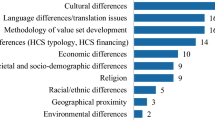Abstract
Background
Despite the growing importance of the EQ-5D descriptive system as a basis for the valuation of QALYs in cost-utility analysis, for most countries, there are no EQ-5D value sets. Researchers and policy makers wishing to use the EQ-5D descriptive system in a country for which there is no value set are advised to use one from a nearby or ‘similar’ population. Factors other than geographic proximity can affect the relative values of EQ-5D states.
Objective
This study explores the links between national culture and EQ-5D value sets.
Method
Rank correlation analysis is used to explore relationships between the relative values of a set of EQ-5D states and dimensions of national culture. The latter are taken from Hofstede’s framework which operationalizes national culture in five dimensions.
Results
For the data currently available (countries for which EQ-5D value sets and scores on dimensions of culture both exist), moderate and strong correlations were found between the culture dimension of power distance and individualism and the EQ-5D dimensions of pain/discomfort and anxiety/depression. Moderate correlations were also observed between the cultural dimension of masculinity and the EQ-5D dimensions of self care, usual activities and pain/discomfort. Uncertainty avoidance correlates with the EQ-5D dimension of anxiety/depression.
Discussion
The correlation patterns observed are generally consistent with a priori expectations based on the nature of the dimensions of culture and the EQ-5D model. This analysis demonstrates the potential of national culture in providing insight into the drivers of the relative values of EQ-5D dimensions for different countries and in informing decisions about which EQ-5D value sets to use in situations where one does not exist.


Similar content being viewed by others
Notes
This extends to serious illness. Article: in some cultures, cancer stirs shame—Wall Street Journal, October 4th 2008.
References
Devlin, N., & Parkin, D. (2007). Guidance to Users of EQ-5D Value Sets. In A. Szende, M. Oppe, & N. Devlin (Eds.), EQ-5D Value Sets: Inventory, Comparative Review and User Guide. Dordrecht: Springer.
Augustovski, F., Irazola, V., Velazquez, A., Gibbons, L., & Craig, B. (2008). Argentine valuation of the EQ-5D health states. Presented at the 25th Plenary Meeting of the EuroQol Foundation.
Knies, S., Evers, S., Candel, M., Severens, J., & Ament, A. (2009). Utilities of the EQ-5D. Transferable or not? Pharmacoeconomics, 27, 767–779.
Cleemput, I. (2004). Can we explain inter-country differences in levels of health? In A. Szende & A. Williams (Eds.), Measuring self-reported population health: An international perspective based on EQ-5D. Springmed Publishing Ltd.
Rebolj, M. (2004). Education and Health. In A. Szende & A. Williams (Eds.), Measuring self-reported population health: An international perspective based on EQ-5D. Springmed Publishing Ltd.
Chuang, L., Kind, V., & Kind, P. (2009). Estimating domestic values for EQ-5D health states using survey data from external sources. Medical Care, 47, 168–175.
Zarate, V., Kind, P., & Chuang, L. (2008). Hispanic valuation of the EQ-5D health states: A social value set for Latin Americans. Value in Health, 11, 1170–1177.
Hofstede, G. (1991). Cultures and organizations: Software of the mind. London: HarperCollins.
Hofstede, G., & Hofstede, G. J. (2005). Cultures and organizations: Software of the mind (2nd ed.). New York: McGraw Hill.
Westbrook, M., & Legge, V. (1993). Health practitioners’ perceptions of family attitudes towards children with disabilities: A comparison of six communities in a multicultural society. Rehabilitation Psychology, 38(3), 177–185.
Szende, A., Oppe, M., & Devlin, N. (Eds.). (2006). EQ-5D value sets—inventory, comparative review and user guide. Dordrecht, The Netherlands: Springer.
Wittrup-Jensen, K., Lauridsen, J., Gudex, C., Brooks, R., & Pedersen, K. (2001). Estimating Danish EQ-5D tariffs using the time and trade off (TTO) and visual analogue scale (VAS) methods. Proceedings of the 18th Plenary Meeting of the EuroQol Group.
Tsuchiya, A., Ikeda, S., Ikegami, N., Nishimura, S., Sakai, I., Fukuda, T., Hamashima, C., Hisashige, A., Tamura, M. (2002). Estimating an EQ-5D Population Value Set: The Case of Japan. Health Economics 11, 341–353.
Min-Woo, J., Sung-Cheol, Y., & Sang-Il, L. (2008). Estimating quality weights for EQ-5D health states with the time trade-off method in South Korea. Value in Health, 11, 1186–1189.
Lamers, L., McDonnell, J., Stalmeier, P., Krabbe, P., & Busschbach, J. (2006). The Dutch tariff: Results and arguments for an effective design for national EQ-5D valuation studies. Health Economics, 15, 1121–1132.
Goliki, D., Jacubczyk, M., Niewada, M., Wrona, W., & Busschbach, J., (2008). Valuing EQ-5D with the time trade-off for the Polish population. Presented at the 25th Plenary Meeting of the EuroQol Foundation.
Macran, S., Kind, P. (1999). Valuing EQ-5D health states using a modified MVH protocol: preliminary results. Presented at the 16th Plenary Meeting of the EuroQol Group.
Shaw, J., Johnson, J., Iannacchione, V., & Coons, S. (2003) US valuation of the EQ-5D health states: Methods, sampling and preliminary analyses. Presented at the 20th Plenary Meeting of the EuroQol Group.
Author information
Authors and Affiliations
Corresponding author
Appendix
Appendix
See Table 5.
Rights and permissions
About this article
Cite this article
Bailey, H., Kind, P. Preliminary findings of an investigation into the relationship between national culture and EQ-5D value sets. Qual Life Res 19, 1145–1154 (2010). https://doi.org/10.1007/s11136-010-9678-5
Accepted:
Published:
Issue Date:
DOI: https://doi.org/10.1007/s11136-010-9678-5




